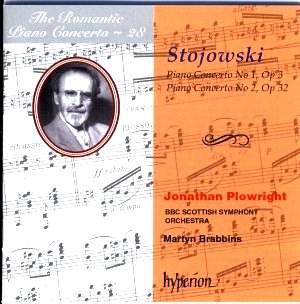Hyperion present two lanky ambitious confident concertos
for the twenty-eighth volume in their Romantic Piano Concerto series.
Stojowski was born Zygmunt Denis Antoni Stojowski in
Strzelce in Poland. Later he adopted the clumsier but perhaps easier
to pronounce 'Sigismund'. Abandoning early studies in Cracow he went
to Paris and there worked with Diémer, Dubois, Massenet and Delibes.
In 1891 he gave a concert of his own works with the Colonne Orchestra.
This was the forum for the First Piano Concerto and the Ballade for
orchestra. Paderewski gave him piano lessons. European tours as soloist
culminated in emigration to the USA in 1905 - the same year as
his almost namesake, Leopold Stokowski. He settled in New York and played
in concert with all the major US orchestras. Stojowski spoke and wrote
six languages and corresponded in phenomenal quantity all over the world.
There are in excess of one hundred compositions. Paderewski
played his Rhapsodie Symphonique (1907) in New York (and there
is, by the way, a recording of this work on ABC Classics). Marcella
Sembrich-Kochanska sang his songs. His violin pieces were played by
Wilhelmj, Kochanski and Enescu. The works include Symphony in D minor
(1901), Violin Concerto (1908), Cello Concerto, two violin sonatas (1894,
1912), cello sonata (1898) and these two piano concertos (1893, 1914).
His Prayer for Poland was written for chorus and orchestra in
1916 and presumably parallels the wartime sentiments of Elgar's Polonia.
The opening of the First Concerto is like a
great wave slowly cresting and breaking as a prelude to a moonlit episode.
It may well have been heard and imbibed by Stanford for I felt the parallels
with Stanford's 1912 Second Concerto quite frequently. This is a case
of Stanford crossed with Saint-Saëns - perfumed and loquacious
- spinning fantasy and commonplace side by side. There is some magically
still poetry in the lento at 09.00 and this is picked up in the
andante which takes something from Beethoven's Moonlight and
Pastoral. The allegro con fuoco? Well, if the attention
intermittently drifts and the thematic interest is slender, the experience
is pleasing - a period piece.
The Second Concerto is also known by its triptychal
title. There are ten variations preceded by the theme and each episode
is separately tracked. Stojowski does much better here and sentimentally
viscous though it may be the great theme in the prologue at 0600 is
one of which to be proud even though it gets some rowdy quasi-vaudeville
pacing as things progress. The theme has Slavonic overtones and is given
the full glittering treatment. Stojowski brings a great feeling of heroic
summation and breadth. He catches the same mood as Medtner in the leonine
drawing of breath and surging forward of the last five minutes of the
Ballade Concerto. On top of this Stojowski reintroduces the strong
theme from the first movement and does it extremely well. The work ends
consummately and calmly; the work of a composer confident in his own
powers.
Jonathon Plowright has done well here. I do not underestimate
the work that goes into these projects. I am sure that Stojowski would
have been proud of Plowright's work which advocates these concertos
to a generation to whom the two concertos were strangers. The only criticism
across the concertos would be that when the strings of the BBC Scottish
'lean' on the big lyrical themes they do not sound as affluent and well-nourished
as they might.
Hyperion attain their usual resplendent standards in
all departments. Joseph A Herter's notes are de rigueur and are
much more than a summation from the easily available enyclopaedic sources.
His performance history from the 1890s up to date makes good reading.
While I would happily have settled for less depth these notes complete
the picture and make acquisition of this disc a comprehensive experience.
The notes are in French and German as well ... and in full. No corners
cut.
Now Hyperion we hope you will not stop this series.
We still need the two (2 and 3 not to mention the two symphonies) by
Bortkiewicz, Holbrooke's Second Orient and Symphony No. 8 Dance
for piano and orchestra, Joseph Marx's Castelli Romani (effectively
his second concerto), the concertos of Roger Sacheverell Coke
(a British
Rachmaninov disciple), two piano concertos by Théo Ysaye (1865-1918,
the brother of Eugène) and Arthur Somervell's Highland Concerto
(1920) and Normandy Variations (1910) for piano and orchestra.
Rob Barnett


